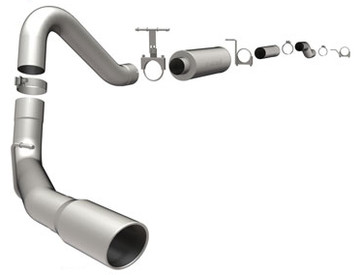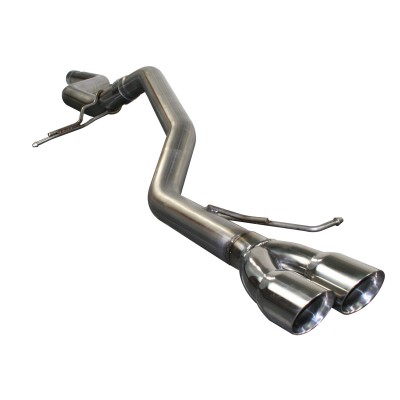It’s widely known that upgrading your factory system to a performance diesel exhaust is a great way to increase your engine’s power and fuel economy. Because of all the changes to stock emissions systems over the past few years, there now exists some confusion and questions among diesel owners as to which exhaust upgrade is the best option for them. Parleys Diesel Performance wants to help you make an informed and educated choice, so let’s start by reviewing the basics.
Traditionally, light duty diesel truck factory exhaust systems were 3 inches or 3.5 inches in diameter, with crimped spots along the diesel exhaust system that hampered flow and robbed your vehicle of its true potential. Installing a performance system to increase the diameter of your exhaust allowed your engine to expel exhaust gasses more efficiently, and mandrel bends gave your exhaust a true 4″ diameter. Diesel trucks today come from the factory with catalytic converters, diesel particulate filters, even urea injection systems (also called SCR or selective catalytic reduction). And 4 inch stock exhausts are commonplace.
Late Model Exhaust Diagram

So which exhaust should you choose for your truck?
If you have a “pre-DPF” diesel pickup (anything before the 2007.5 6.7L Cummins, 2008 6.4L Powerstroke, or 2007.5 Duramax LMM) the most common diesel exhaust upgrade is a four inch turbo back exhaust system. The standard 4″ diameter will meet most people’s needs; however, if it’s your intention to upgrade your vehicle to a high horsepower level (think over 550HP), we recommend you invest in a 5″ diesel performance exhaust system. This will allow the larger amount of exhaust your high horsepower diesel creates to flow properly and keeping temperatures down.

In addition to figuring out the diameter of the exhaust system you want for your truck, there are also some other important choices to make. Diesel exhaust systems come in four main materials: T-304 Stainless Steel (high-polish show finish quality), 409 Stainless Steel , Aluminized Steel (similar to your original stock exhaust), and different variations of Black Stainless or Black Aluminized Steel. You also need to decide whether you want to have a muffler or not, and if you do choose a muffler, do you want one that is a high flow performance muffler or one that keeps your exhaust volume low. The majority of Turbo-Back Exhausts come with high flow performance mufflers. If you want a “straight pipe” exhaust, meaning no muffler, a popular choice is the no-muffler series from MBRP Performance Exhaust. Their stainless steel SLM (Stainless Less Muffler) and PLM (Performance Less Muffler – this is aluminized steel) are very competitively priced and work great.

Although less popular, catalytic converter or Cat-Back Diesel Exhausts allow you to upgrade the sound and flow of your exhaust and in some areas are necessary to keep your diesel street legal.

With exhaust systems from all the best manufacturers, Parley’s Diesel Performance can help you choose the proper diesel exhaust system for your truck. Whether you choose to install a Cat-Back or a Turbo-Back diesel exhaust, or if you just aren’t sure and would like help deciding, contact us and we’ll help you make the right decision. In part 2, we’ll help you choose the right exhaust system if you own a DPF-equipped diesel truck.









